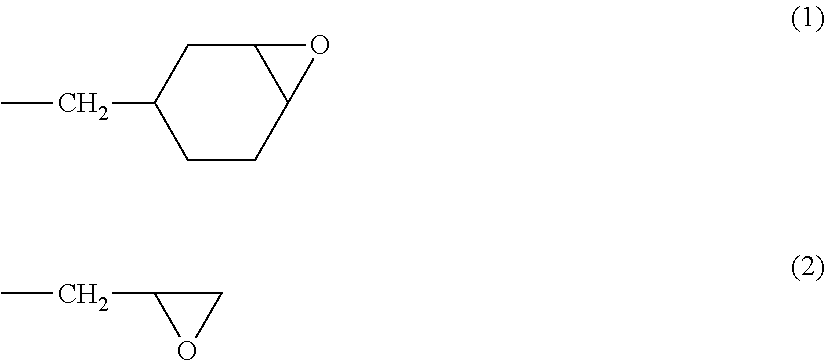Crosslinking polymer-supported porous film for battery separator and method for producing battery using the same
a technology of polymer-supported porous film and battery separator, which is applied in the direction of cell components, final product manufacturing, sustainable manufacturing/processing, etc., can solve the problems of deteriorating battery performance, increasing the internal resistance of the battery, and partially extending the distance between the electrodes, etc., to achieve low internal resistance, high-rate performance, and sufficient adhesiveness
- Summary
- Abstract
- Description
- Claims
- Application Information
AI Technical Summary
Benefits of technology
Problems solved by technology
Method used
Image
Examples
reference example 1
Preparation of Electrode Sheet
[0060]85 Parts of lithium cobalt oxide as a positive electrode active material (Cell Seed C-10 manufactured by Nippon Chemical Industrial Co., Ltd.), 10 parts of acetylene black as a conductive auxiliary agent (Denka Black manufactured by Denki Kagaku Kogyo Kabushiki Kaisha) and 5 parts of a vinylidene fluoride resin as a binder (KF polymer L #1120 manufactured by Kureha Chemical Industry, Co., Ltd.) were mixed together. Using N-methyl-2-pyrrolidone, a slurry of the resulting mixture was prepared so as to have a solid concentration of 15% by weight. The slurry was applied to one side of a 20 μm thick aluminum foil (current collector) at a build-up of 200 μm, dried at 80° C. for 1 hour and then at 120° C. for 2 hours, and pressed with a roll press, to prepare a positive electrode sheet having an active material layer thickness of 100 μm.
[0061]80 Parts of mesocarbon microbeads as a negative electrode active material (MCMB 6-28 manufactured by Osaka Gas Ch...
production example 1
[0064]Production of 3-oxetanyl Group-Containing Crosslinking Polymer A (Weight Average Molecular Weight: 518,000 and Content of 3-oxetanyl Group-Containing Monomer Content: 25% by Weight)
[0065]60.0 g of methyl methacrylate, 20.0 g of 3-ethyl-3-oxetanylmethyl methacrylate, 158.0 g of ethyl acetate and 0.16 g of N,N′-azobisisobutyronitrile were placed in a 500 ml three-necked flask equipped with a reflux condenser, and mixed for 30 minutes under stirring while introducing nitrogen gas. Radical polymerization was initiated at 60° C. When about 2 hours passed, the viscosity of the reaction mixture began to increase. The reaction mixture was further polymerized for additional 8 hours. The reaction mixture was cooled to about 10° C., and 0.16 g of azobisbutyronitrile was added thereto. The resulting mixture was again heated to 70° C., and polymerization was conducted for 8 hours.
[0066]After completion of the reaction, the reaction mixture was cooled to about 40° C., and 295 g of ethyl ace...
production example 2
[0068]Production of 3-oxetanyl Group-Containing Crosslinking Polymer B (Weight Average Molecular Weight: 253,000 and Content of 3-oxetanyl Group-Containing Monomer Component: 15% by Weight)
[0069]In the same manner as in the Production Example 1, 68.0 g of methyl methacrylate, 12.0 g of 3-ethyl-3-oxetanylmethyl methacrylate, 158.0 g of ethyl acetate and 0.15 g of N,N′-azobisisobutyronitrile were placed in a 500 ml three-necked flask equipped with a reflux condenser, and mixed for 30 minutes under stirring while introducing nitrogen gas. Radical polymerization was initiated at 70° C. When about 1.5 hours passed, the viscosity of the reaction mixture began to increase. The reaction mixture was further polymerized for additional 8 hours. The reaction mixture was cooled to about 40° C., and 0.15 g of azobisbutyronitrile was added thereto. The resulting mixture was again heated to 70° C., and polymerization was conducted for 8 hours.
[0070]After completion of the reaction, the reaction mix...
PUM
| Property | Measurement | Unit |
|---|---|---|
| thickness | aaaaa | aaaaa |
| thickness | aaaaa | aaaaa |
| porosity | aaaaa | aaaaa |
Abstract
Description
Claims
Application Information
 Login to View More
Login to View More - R&D
- Intellectual Property
- Life Sciences
- Materials
- Tech Scout
- Unparalleled Data Quality
- Higher Quality Content
- 60% Fewer Hallucinations
Browse by: Latest US Patents, China's latest patents, Technical Efficacy Thesaurus, Application Domain, Technology Topic, Popular Technical Reports.
© 2025 PatSnap. All rights reserved.Legal|Privacy policy|Modern Slavery Act Transparency Statement|Sitemap|About US| Contact US: help@patsnap.com



